Every year, I take the work of our talented Gun Tests team testers and select the top-graded products they’ve reviewed. Long guns, short guns, ammunition and accessories all get considered for a coveted spot on the Gun TestsA List. I design this list as a shopping guide for readers – only the best of an entire year’s worth of gun reviews, abridged for your convenience, in one article. After we roll high-rated test products into long-term testing, I keep tabs on how those guns do, and if the firearms and accessories continue performing well, then I have confidence including them in this wrap-up. Special thanks to the Gun Tests team testers for doing the dirty work: R.K. Campbell, Roger Eckstine, Austin Miller, Robert Sadowski, David Tannahill, Tracey Taylor, John Taylor, and Ralph Winingham.
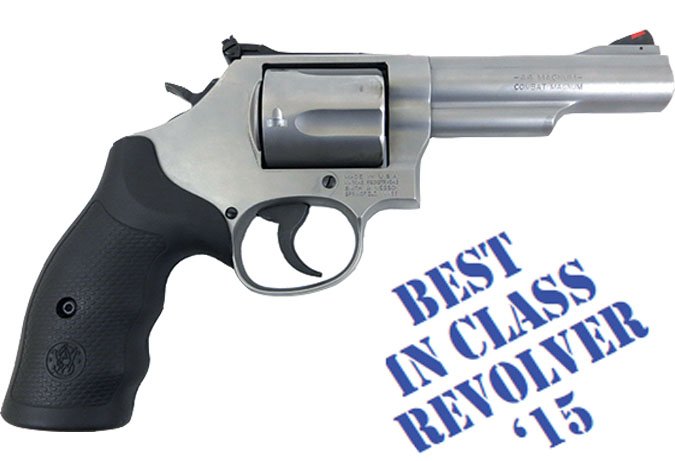
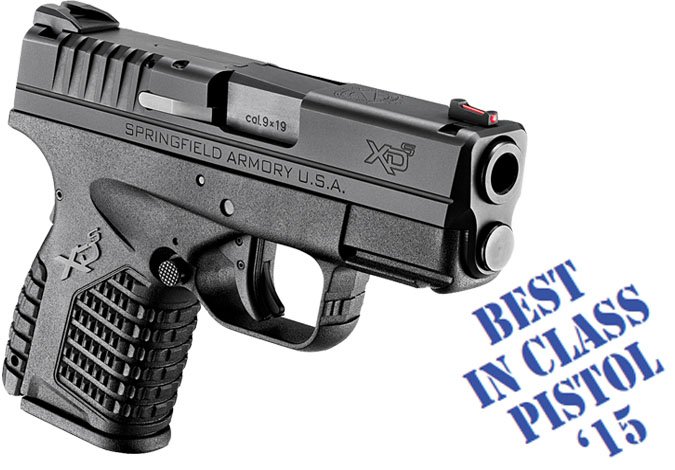



Springfield Armory XD-S 3.3 XDS9339B
9mm Luger, $494
Gun Tests grade: A (Our Pick)
BEST IN CLASS PISTOL
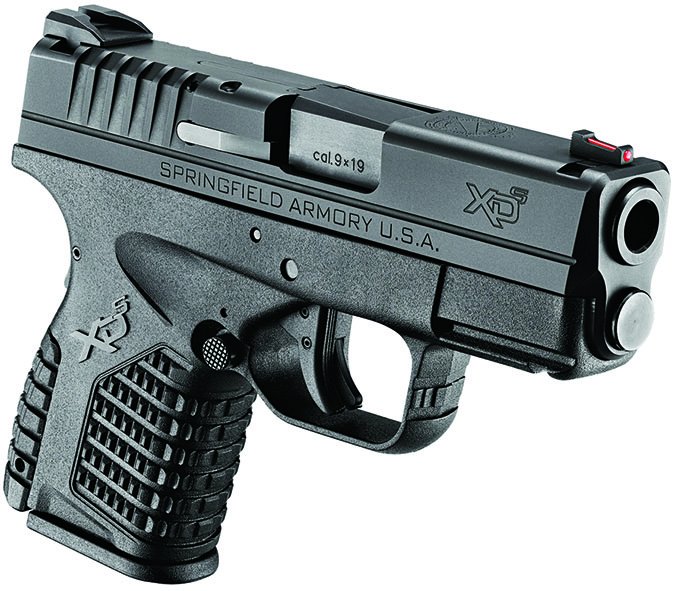
The XD-S was a great shooter. Its accuracy was the best of the handguns tested. The pistol was reliable. We liked the safety features. With the extended magazine, the XDS also offers ten shots for home defense.
| STATS | |
|---|---|
| ACTION | Locked Breech DAO Semi-Auto |
| OVERALL LENGTH | 6.3 inches |
| OVERALL HEIGHT | 4.43 inches |
| OVERALL HEIGHT w/ EXTENDED MAG | 5.43 inches |
| MAXIMUM WIDTH | 0.9 inches |
| WEIGHT UNLOADED | 23 ounces |
| WEIGHT LOADED | 26 ounces |
| BARREL LENGTH | 3.3 inches |
| BARREL | Melonite-finish Steel |
| CAPACITY | 7+1 |
| MAGAZINES | 2, Stainless Steel |
| FRAME | Textured Black Polymer |
| FRAME FRONT STRAP HEIGHT | 1.9 inches |
| FRAME BACK STRAP HEIGHT | 2.75 inches |
| SLIDE | Melonite-finish Steel |
| GRIP THICKNESS (MAX) | 0.9 inches |
| GRIP CIRCUMFERENCE | 5.75 inches |
| SIGHTS | Fiber-Optic Front, Steel Dovetail Rear |
| TRIGGER PULL WEIGHT | 7 lbs. |
| TRIGGER SPAN SINGLE ACTION | 2.6 inches |
| SAFETY | No Manual Safety |
| WARRANTY | Lifetime Limited |
| WEBSITE | SpringfieldArmory.com |
| MADE IN | Croatia |
The Springfield Armory XD-S 3.3 XDS9339B 9mm Luger, $494 is a highly modified XD that stands on its own merits. It resembles the larger XD pistols, but the operation is different. The pistol featured a dust cover on the rear of the slide rather than the characteristic exposed striker of the larger XD. The stippling and surface abrasion of the Springfield were ideal for our shooters. The finish was never uncomfortable, and the grip was never in question. The XD was also the only handgun with an ambidextrous magazine release. Takedown was via a lever, a feature on larger service-grade handguns.
The low profile sights featured a red fiber-optic front component and a drift-adjustable steel rear sight. This made for good results when running a combat course at high speed. We began the combat course with the Black Hills 115-grain FMJ load, progressed to the HPR 115- and 124-grain loads, and fired a single magazine of the Cor-Bon DPX load. Results were excellent. We were able to keep the steel plates ringing and combat groups were excellent, but then this was the heaviest handgun and the one with the longest barrel. During this time at the range, we thought the trigger compression was suitably controllable at 7.0 pounds.
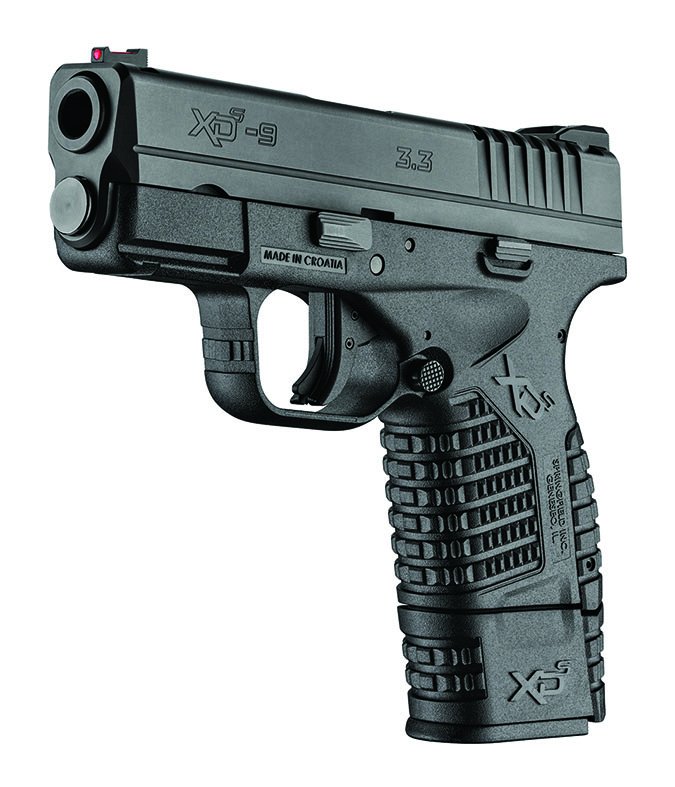
Early on, we experienced a failure of the slide to lock back on the last round after every magazine and with both magazines. After the first four magazines of ammunition, the slide began to lock back. This may have been shooter error, as we may have rode the thumb on the slide lock. Also, on several occasions, we felt that too much effort was needed to operate the magazine release. Again, this cleared up during the test. Perhaps we simply needed to learn the touch. In any case, the slide never locked back during a firing string, so we were not applying upward pressure during recoil — a neat bridge on the frame prevents this from happening. Each handgun must be learned for its own merits and foibles.
Once the magazine-release problem was solved, the pistol exhibited excellent speed in magazine replacement. We fired with both the 7-round and the optional 9-round magazine. There wasn’t a lot of difference. If maximum concealment is needed, the shorter magazine works well, while the longer magazine gives 10 rounds at the ready when concealment isn’t as important.
When firing for accuracy off a bench rest, the Springfield put out the best averages across the board, most notably 2.0 inches with the HPR 115-grain JHP loading.
Our Team Said: The XD-S is supplied with a range holster, magazine carrier, and a spare magazine. The Springfield also had a rail, a loaded-chamber indicator on the top of the slide, and grip inserts. If you are willing to spend the extra money and carry the pistol in an inside-the-waistband holster rather than the pocket, the XD-S represents a good option. The Springfield, in the words of one rater, “Shoots like a big gun.”
Smith & Wesson M69 162069 44 Magnum, $849
Gun Tests grade: A
BEST IN CLASS REVOLVER
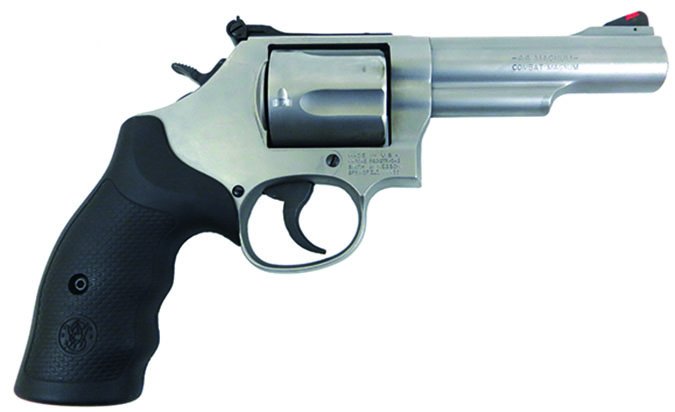
The new Model 69 from Smith & Wesson is an excellent downsized 44 Magnum with a good, smooth trigger pull in DA and crisp in SA. The sights were well designed and user friendly.
| STATS | |
|---|---|
| ACTION | Double Action |
| OVERALL LENGTH | 9.75 inches |
| OVERALL HEIGHT | 6 inches |
| MAXIMUM WIDTH (Cylinder) | 1.6 inches |
| WEIGHT UNLOADED | 37.2 ounces |
| WEIGHT LOADED | 39.8 ounces |
| BARREL LENGTH | 4.25 inches |
| CAPACITY | 5 |
| FRAME MATERIAL/SIZE | Stainless Steel L-frame |
| CYLINDER MATERIAL | Stainless Steel, Fluted |
| FRAME FRONT STRAP HEIGHT | 2.2 inches |
| FRAME BACK STRAP HEIGHT | 4.2 inches |
| GRIPS | Rubber Finger Groove |
| GRIP THICKNESS (MAX) | 1.2 inches |
| GRIP CIRCUMFERENCE | 5.7 inches |
| FRONT SIGHT | Red Ramp |
| REAR SIGHT | Adjustable White Outline |
| SIGHT RADIUS | 6 inches |
| TRIGGER PULL WEIGHT SINGLE ACTION | 4.8 lbs. |
| TRIGGER PULL WEIGHT DOUBLE ACTION | 12 lbs. |
| TRIGGER SPAN SINGLE ACTION | 2.6 inches |
| TRIGGER SPAN DOUBLE ACTION | 3.3 inches |
| SAFETY | None |
| WARRANTY | Lifetime |
| WEBSITE | Smith-Wesson.com |
| MADE IN | Massachusetts |
The Model 69 Combat Magnum debuted in 2014 and is a departure from S&W’s typical 44 Magnum revolvers. The new Model 69 is built on an L-frame, which Smith brought out in 1980 for the 357 Magnum. An N-frame revolver is S&W’s typical frame used for the 44 Magnum. To fit the caliber in the L-frame, the cylinder capacity was reduced to five shots; N-frames have six shots. There is nothing special in the metallurgy of the L-frame, S&W’s current heat-treating process already makes the metal plenty strong enough to handle the pressures from a 44 Magnum. S&W did, however, have to change the geometry on the cylinder crane so the cylinder would close without hitting the barrel inside the frame.
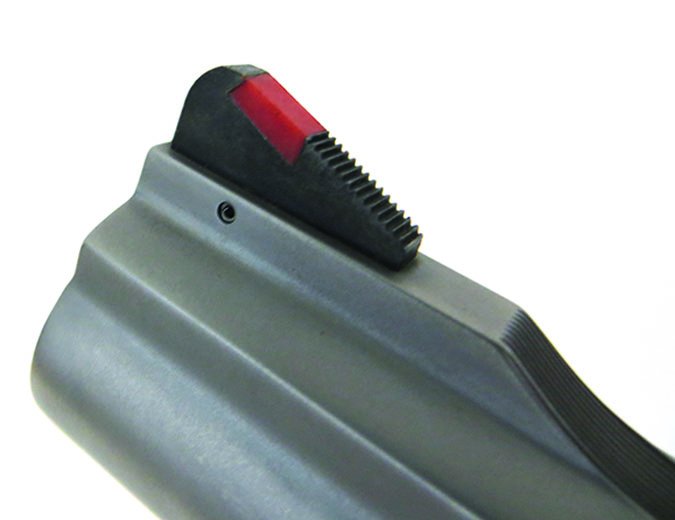
The Model 69 is constructed of stainless steel and wears a glass-bead-matte-stainless finish. Barrel length is 0.25 inch longer than the other reviewed revolvers. The two-piece barrel was made with a stainless-steel barrel shroud over a steel barrel. The Smith used a half lug under the barrel. The top of the barrel was serrated, and at the muzzle was a pinned serrated blade with a red insert. The fully adjustable rear sight also had a white outline around the notch. This was an excellent set up, according to our crew. The top strap of the frame was also drilled and tapped under the rear sight, which could also be removed and an optic attached if so desired.
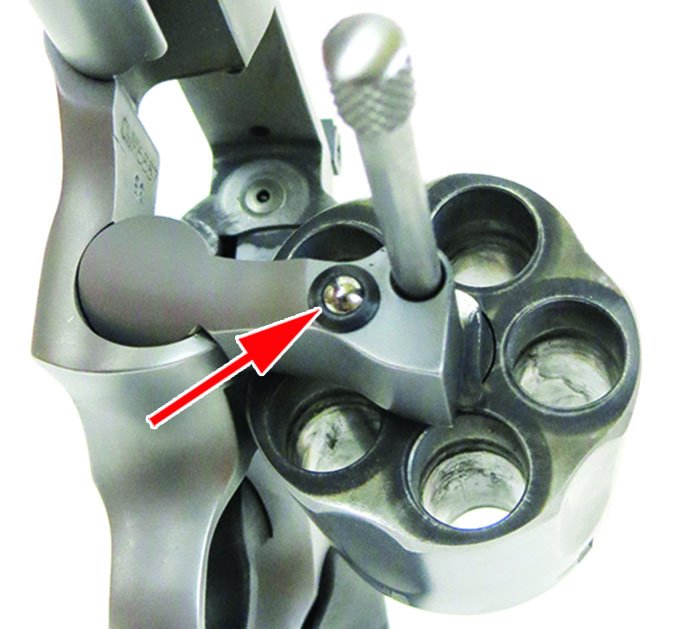
The trigger, hammer, and cylinder latch were blued and contrasted nicely with the rest of the revolver’s finish. The trigger was smooth, and the hammer spur offered plenty of traction to thumb back the hammer and fire in single action. The cylinder latch was precise, and we had no doubt the cylinder was locked up tightly when we shot it.
At the front of the crane was a ball detent that locked into a V-shaped groove in the frame. Team members liked this set-up better than the cylinder lock on the Taurus. We felt it was better built and locked the cylinder into the frame better. With the cylinders swung open, we could also see the spaces between the chambers on the Model 69 were beefy, so pressure was not an issue.
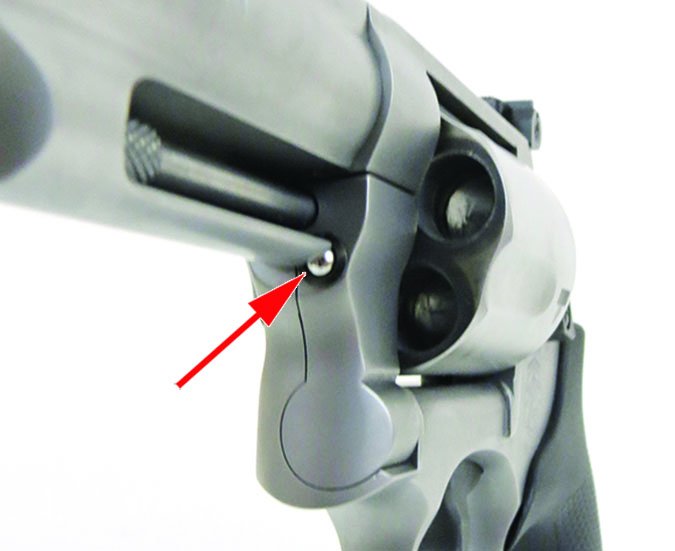
The Model 69 also placed the cylinder notches directly between the chambers where there was the most metal. We thought the cylinder was plenty tough. The Smith also had a long ejector rod that better ejected empty cases than other revolvers.
The Smith’s hard-rubber grip with slight finger grooves and a slight palm swell had a nice texture and felt good in the hand for most reviewers.
In action, the Model 69 was a pussycat with 44 Special ammo. Recoil was very manageable for experienced shooters, but this is still not a novice’s revolver. Change to 44 Magnum and the Model 69 was a real wrist cracker, according to some testers. The lighter weight of the L-frame, compared to the typical N-frame, made felt recoil more pronounced with hotter loads.
Accuracy with the new Black Hills ammo was excellent. Using a rest and firing in single-action mode, we were able to shoot groups under an inch at 25 yards. The Model 69 seemed to like the slower bullets. The faster Sellier & Bellot ammo, with a muzzle velocity of 1188 fps, gave larger groups. The Black Hills 44 Magnum and Remington 44 Special clocked at 956 fps and 679 fps, respectively.
We used an OWB holster to carry the Model 69 a trail gun. Reviewers thought it would make a great deer gun for use at bow-hunting range.
Our Team Said: The new S&W Model 69 is an excellent revolver that’s well made and nicely finished, with very usable sights and a smooth trigger in double action that is also crisp in single action. Irrespective of its heavy price, team members would buy the Model 69 to hang on their belts.
Mitchell’s Mauser M48 8x57mm, $450
Gun Tests grade: A
BEST IN CLASS RIFLE

Looking very much like a wartime Mauser 98K, the Mitchell Mauser M48 is not German, but Yugoslavian, made after WWII in the late 1940s and preserved unused since then. We liked the way this one shot and felt with mil-spec ammo.
| STATS | |
|---|---|
| ACTION TYPE | Bolt |
| OVERALL LENGTH | 43 inches |
| BARREL LENGTH | 23.2 inches |
| BARREL FINISH | Blued |
| MAGAZINE TYPE | Box |
| SIGHT RADIUS | 20 inches |
| OVERALL HEIGHT | 6.7 inches |
| STOCK | Teak |
| TRIGGER PULL WEIGHT | 6.5 lbs. |
| LOP | 13.1 inches |
| WEIGHT UNLOADED | 8.6 lbs. |
| WEIGHT LOADED | 8.9 lbs. |
| CAPACITY | 5 |
| ACTION FINISH | Blued |
| WARRANTY | Money-Back Guarantee |
| WEBSITE | Mauser.org |
| MADE IN | Yugoslavia |
Our first look at the Mitchell Mauser M48 Collector Grade 8×57 JS (8mm Mauser) gave us hope that here we had an essentially new 98 Mauser to play with. The bore, finish, wood and all the stuff that came with it looked new, except that some of the accessories showed some age marks. This version came with a fancy certificate along with a leather sling, bayonet in scabbard, leather frog or bayonet hanger, leather ammo pouch, and a field cleaning kit. The certificate stated the rifle had been in military storage since its manufacture in Yugoslavia during the 1940s. It went on to state the rifle had been inspected and tested every five years since its storage, essentially stating these are not newly made replicas, but older original Mausers. The M48 Mausers were made in Yugoslavia after WWII — presumably in 1948 and after — so there is no reason to doubt these are in fact all original. They came from a factory or arsenal that has been in Yugoslavia since the late 1800s.
There is, in fact, lots of commentary online to the effect that these so-called all-original rifles from Mitchell’s have been gussied up, restamped (all the numbers of our test rifle match, even the stock), reblued, refinished, and the like. Was this rifle ground down, restamped with all-matching numbers, and then reblued? Then how come the crest is pristine? Was the metal completely buffed, reblued, new barrels stuck in and the wood sanded and refinished? No, it was not, because in the first place there would be no profit in doing so. Also, the stock is by no means skimpy. It’s proud of the wood everywhere, which refinished wood would not be. The M48 rifles were made after WWII, and they could easily have been put in storage because there was no great need for them. Because the Germans had nothing to do with the making of these rifles that came from an ancient armory or factory, there is no reason the Yugos would have used older German stamps to mark them, and that puts the lie to some claims the numbers don’t have the right font characteristics. At any rate, we took a look at the rifle as it was, not from the viewpoint of the conflicting opinions online.
One thing is for sure, this rifle has all nice stuff throughout. The barrel is pristine. The stock is in excellent condition, as is the bluing. The accompanying certificate told us the stock was in fact “teakwood,” not walnut. We wonder about that, but don’t have any teak on hand to compare with it. It does look like photos of teak we’ve seen online. The wood is very hard, has some decent grain, and has a dull finish of some sort. It seems to be a reasonable stock wood. All in all, we thought the rifle looked pretty good, and would make a fine display for some folks, whether or not it would satisfy every Mauser collector. Of course the intent is for it to be shot, so of course we shot it. We did that with three types of ammo, mil-spec hardball of unknown origin from 1983 with a 198-grain, steel-jacketed, boat-tail bullet; Remington 170-grain Core-Lokt SP; and PMC 170-grain PSP. We were going to try another mil-spec steel-case ammo from Romania, but it would not chamber. Here’s what we found.
Although it looked mighty good, the rifle didn’t have milled parts throughout. The trigger guard and floor plate were stampings. The forward stock-retention ring of the Mitchell M48 Mauser is one of the later, stamped and welded-up ones. Missing is the hole in the butt for removing the firing pin from the bolt sleeve. Early on, we found a problem that the buyers of these ought to address right from the start. The wrap-around or cup-like butt plate is polished steel, left in the white. There was apparently nothing much put on it to preserve it, maybe a wipe of Cosmoline, but not enough to protect it once the rifle is removed from its plastic wrapping. The butt plate began to rust almost immediately, and when we tested it in wet snow we really began to have problems. Our fix was to restore its look with Scotch-Brite and then put a heavy coat of wax on it to prevent rusting. We strongly advise you to do the same thing to actively prevent rusting of a major, highly visible, portion of this old rifle.
The rifle had the secondary locking screws on the action-retention bolts going through the trigger guard. The bolt handle was bent downward and the bottom of the knob was flattened. The bolt was in the white, as were the bolt shroud, firing pin cap, and the safety. The magazine follower was beveled to allow the bolt to run forward with the magazine empty. The left side of the action had “PREDUZECE 44” in Cyrillic letters, verifying its Yugoslav origin. The top of the front action ring had a nicely imprinted crest. Below that was “M 48A.”
The rear sight was, from what one collector told us, made to the pattern of an early German version, with the yardage markings (to 2000) on both the top and bottom. The front sight had a dust cover, which was nice to see. It aided our shooting efforts. The wood was like new with a dull finish that begged for some linseed oil. But if it is in fact teak, it might not take oil well. The trigger pull was two-stage, with some creep to the final pull. It broke at 6.5 pounds. We wiped the like-new bore and took it to the range.
Our first group was with the mil-spec ammo (unknown origin), and went into 2.3 inches at 100 yards from our bench rest. With the military ammo, the rifle printed right where it ought to have, dead center and a touch high with the rear sight all the way down. However, a problem showed up right away. The rifle would not reliably eject. It fed and fired perfectly, but the spent case just lay there, no matter how vigorously we worked the bolt handle. The ejector was not stuck in the Cosmoline, and it had good spring force. It protruded the correct amount (not much). The few cases that did eject just dribbled out of the rifle. A good Mauser will fling them far. On inspection we found that despite our initial cleaning, some odd crud remained inside the magazine box that apparently was flaking off and interfering with ejection. Once that was removed, ejection was as it ought to have been.
The two soft-nose commercial loads were much “softer” than the military version. We well recall the excellent surplus 8mm from several decades ago that was like new. It was mighty hot stuff, made in Canada and intended for the Bay of Pigs (never got there), and was not watered down like the commercial ammunition for these old rifles has to be these days. The Remington ammo did give decent accuracy, but the PMC was nothing to write home about. Also, a 170-grain bullet at less than 2200 fps is a mighty light load for what, with the right fodder, can be a mighty rifle.
Our Team Said: We liked this rifle. All in all, we couldn’t fault it. We’ve seen much better — or perhaps we should say more desirable — military Mausers, but not within the past, oh, 40 years. If we wanted an excellent-condition, safe-to-shoot, Mauser made after the design of the late-war Wehrmacht’s rifles, we’d buy this one.
Remington 870 Tactical 81200 12 Gauge, $442
Gun Tests grade: A (Best Buy)
BEST IN CLASS SHOTGUN

Remington’s proven 870 shotgun keeps on shooting, despite a number of cost-cutting measures, such as a plastic trigger-group housing, matte finish and synthetic hardware.
| STATS | |
|---|---|
| ACTION TYPE | Pump |
| OVERALL LENGTH | 39 inches |
| OVERALL HEIGHT | 5.25 inches |
| CAPACITY | 6+1 |
| WEIGHT UNLOADED | 7.5 lbs. |
| WEIGHT LOADED | 8.3 lbs. |
| BARREL LENGTH | 18.5 inches |
| BARREL | Steel |
| RECEIVER | Steel |
| STOCK & FOREND | Synthetic |
| SIGHTS | Bead Front Post |
| TRIGGER PULL WEIGHT | 6.5 lbs. |
| WARRANTY | 2 Years |
| WEBSITE | Remington.com |
| MADE IN | USA |
The Remington 870 Tactical Model was supplied with a black synthetic stock and forend, a plastic trigger assembly, a six-round magazine, a bead front sight, and a muzzle brake that Remington calls a tactical choke. There is a slightly less expensive variant without the tactical choke. The 81198 version features rifle-like sights. The version tested features a receiver drilled and tapped for scope mounts. On an all-round defensive shotgun, the bead front sight did not bother us at all; in fact, we found it ideal for pointing at close-in targets.
Pointed teeth around the end of the muzzle brake were similar to the special door-breaching-braked shotguns used by the military. These jagged edges are intended to tear into a wooden door, break windows, and otherwise damage stuff, and the ports stabilize the muzzle during rapid firing. The synthetic buttstock featured stippling at the grip that made for good adhesion. The synthetic forend looked skimpy compared to wide wooden forends, but it fit all our hands well and performed well in all testing with all raters. The Remington’s dual action bars gave good, smooth cycling.
The safety was located at the rear of the trigger guard, and its operation was positive and sure. The Remington’s safety location was easily manipulated by the shooter.
As we have done for some time, we began the test with Winchester birdshot, just to get the feel of handling the shotgun. The six-shot tubular magazine was easily loaded.
Our Team Said: The 870’s 18.5-inch-long barrel handled quickly in close quarters with both reduced-power buckshot loads and full-power loads. Recoil was what we expected with full-power buckshot, but it wasn’t harsh. There were no shooter-induced malfunctions, no short cycles, and no problems.
Roessler Titan 6 Luxus 300 Win Mag. $1980
Gun Tests grade: A

While its Bavarian styling might not be for everyone, the Titan was easy on the shooter despite the rifle’s light weight. We liked the fine walnut and its oil finish. The stock design allowed the shooter’s head to be held high, and the slight castoff in the butt made for comfortable, easy shooting for our shooters.
| STATS | |
|---|---|
| OVERALL LENGTH | 47.2 inches |
| BARREL LENGTH | 26 inches |
| BARREL FINISH | Blued |
| MAGAZINE TYPE | Detachable |
| SIGHT RADIUS | N/A |
| OVERALL HEIGHT | 8.5 inches |
| STOCK | Italian Walnut |
| TRIGGER PULL WEIGHT | 2 lbs. |
| LOP | 14.5 inches |
| WEIGHT UNLOADED (NO SCOPE) | 7 lbs. |
| WEIGHT LOADED | 7.8 lbs. |
| WEIGHT SCOPED (4X LEUPOLD) | 7.7 lbs. |
| CAPACITY | 3 Rounds |
| ACTION FINISH | Black Anodized |
| ACTION TYPE | Bolt |
| WARRANTY | 5 Years |
| WEBSITE | TRimports.com |
| MADE IN | Austria |
| EXTRA 270 WIN. BARREL |
$407 |
| EXTRA 270 WIN. BOLT | $368 |
Among the other Gun Tests recommended guns of the year is the Roessler Titan 6 bolt action made by Roessler Waffen and imported to the United States by TR Imports near Dallas (TRImports.com). That website has a good short video explaining the Titan rifles.
Roessler is a small, independent gun maker based in Kufstein, Austria. The company began in 1996 with the intent of building top-notch hunting rifles that incorporate innovation and a classic, hand-worked look. As noted, the company offers no fewer than 31 different calibers, from 222 to 375 Ruger. Half a dozen of the smaller ones utilize the Titan T3 action, with three bolt lugs. The remainder are in the T6 setup with its six-lug bolt.
The rifle has an aluminum receiver, available, like the barrels, in two finishes, black or silvery (stainless). The bolt locks into the back of the barrel, not into the receiver. This results in a light rifle with an exceptionally smooth bolt. Further, it permits for easy barrel changing. More on that later.
The stock appeared to be French walnut, though some of the information we managed to find indicates the wood is from Italy. The style is very much to our personal liking, though the average U.S. shooter might not like it, until he tries it on his shoulder. There is a Schnabel in contrasting rosewood. The main stock wood has sufficient grain to keep it well out of the “plank” category. The pistol-grip area is curved and well checkered so one can pull the rifle firmly into the shoulder to alleviate recoil. The recoil pad is slim but entirely sufficient in its design to have kept the rifle from hurting us when shot off the bench with hot 300 Win. Mag. loads with 180-grain bullets. The slight cast-off helps that, too.
The wood has an oiled finish, which makes it easy to repair nicks and dings that are relatively permanent in epoxy-finished stocks. There were sling-attachment points under the forearm and butt. The four panels of checkering were of excellent quality. Fit and finish were excellent everywhere we looked. With an all-up weight of 7.8 pounds with our 4X Leupold attached, we expected the rifle to kick us severely. That did not happen, not from the bench nor while standing. Yes, the barrel rose in recoil significantly when we were standing and shooting the 300 Win. Mag. loads, but the stock design, combined with the good recoil pad, caused us no discomfort.
The barrel length for the 300 Win. Mag. was a full 26 inches, so it got the maximum out of the loads. The 270 had a 22-inch length. Changing barrels was extremely easy.
Testament to the Titan’s system was that our shots were still on the paper, the impact having moved maybe 5 inches down from the change of barrels. The 270 set up performed perfectly, with one of our groups going just under an inch. We happily noted that the rifle preferred the heavier 270 bullets over the 130-grain ones, which matches our own preferences in that caliber.
On the range, the rifle performed flawlessly. Feeding was as slick as we’ve experienced in any rifle. Ejection was by a plunger, and worked just fine. The extractor was reminiscent of the post-’64 Winchesters, a spring-loaded sliding catch. The movement of the bolt in its raceway was also glass-smooth. The trigger was absolutely a wonder. It’s the best we’ve experienced since the Savage AccuTrigger, light, clean, crisp, zero overtravel.
Our Team Said: We think it’s well worth the trouble of looking for the Roessler Titan 6 rifle. We found the Titan offers excellent performance and innovation in an attractive package, plus the option of changing calibers with the twist of a wrench.
Browning Citori Model 725 No. 0135306005
20 Gauge Over/Under, $2470
Gun Tests grade: A

The new kid on the block handles well and patterns like a dream.
| STATS | |
|---|---|
| ACTION TYPE | Over/Under |
| CHAMBER SIZE | 3 inches |
| OVERALL LENGTH | 43 inches |
| CAPACITY | 2 |
| WEIGHT UNLOADED | 6 lbs. |
| BARREL LENGTH | 26 inches |
| BARREL | Polished Blued Steel, Chrome Lined |
| RECEIVER | Low-Profile, Silver-Nitride Finish, Roll Engraving |
| CHOKE TUBES | Invector DS Flush-Fit, IC, M, F |
| STOCK | Checkered Walnut Gloss Oil (Grade II/III) |
| BUTTSTOCK LENGTH OF PULL | 14.5 inches |
| BUTTSTOCK DROP AT COMB | 1.5 inches |
| BUTTSTOCK DROP AT HEEL | 2.6 inches |
| FOREARM | Checkered Walnut Gloss Oil (Grade II/III) |
| FRONT BEAD | Ivory |
| REAR BEAD | Ivory |
| RIB WIDTH | 0.25 inches |
| TRIGGER | 5 lbs. (Bottom & Top), Mechanical |
| WARRANTY | Limited |
| WEBSITE | Browning.com |
| MADE IN | Japan |
Released to the general public in late 2014, the Citori Model 725 in 20 gauge follows a long tradition of Browning’s ventures into the subgauge market.
This field shotgun is both quick and smooth in the handling department, measuring right at 43 inches long and weighing only 6 pounds. With a length of pull of 14.5 inches, the shotgun had a drop at the comb of 1.5 inches and a drop at the heel of 2.6 inches. These dimensions are right on the average mark for an out-of-the-box shotgun, and our team had no problems adjusting to the fit.
Unlike the 12-gauge versions of the Model 725, there is no palm swell in the pistol grip. However, the thin grip with fine checkering was a pleasure to hold and handle. The same checking provides a high-quality grip on the forearm, which is in a modified Schnabel shape.
We really liked the 5-pound touch off of both of the Fire Lite mechanical triggers in the Model 725. Smooth and crisp, the trigger pull on a shotgun may not be as important as the touch off on a centerfire rifle, but a good pull does help put a pattern on targets.
On the clay target range, on the patterning board, and in the field, we found that the new Browning lived up to its advertising claims. Just a little quicker to move with its 26-inch barrel, the Model 725 smacked targets with authority and provided the best pattern when the smokepole was put through its paces on paper. At a range of 30 yards with the Modified choke, the new Browning produced a nearly perfect 54-46 percent pattern (54 percent above the center and 46 percent below) with the pellet spread of the Winchester AA load nearly even across a 30-inch circle. Inside the 20-inch circle at the center of the target, there were 220 pellet hits (yes, we count them) for a solid center punch of 60 percent. This performance was the best of all our patterning tests.
With the Improved Cylinder choke, the Model 725 produced an identical 54-46 percent pattern, with 157 hits in the 20-inch circle for a 51-percent center punch.
Results with the Remington shotshell load were not quite as impressive, but were still quite good. The Modified choke produced a 40-60 percent pattern with 208 hits (58 percent) in the 20-inch center circle; and the Improved Cylinder choke produced a 42-58 percent pattern with 149 pellet hits (55 percent) in the 20-inch center circle.
Our Team Said: It is not a given that the new model on the block will outperform a seasoned veteran, but with the Model 725 in 20 gauge, that is exactly what occurred. The shotgun handled well on the clays course and excelled in the patterning stage of the test.
Colt Commander XSE O4012XSE 45 ACP, $940
Gun Tests grade: A
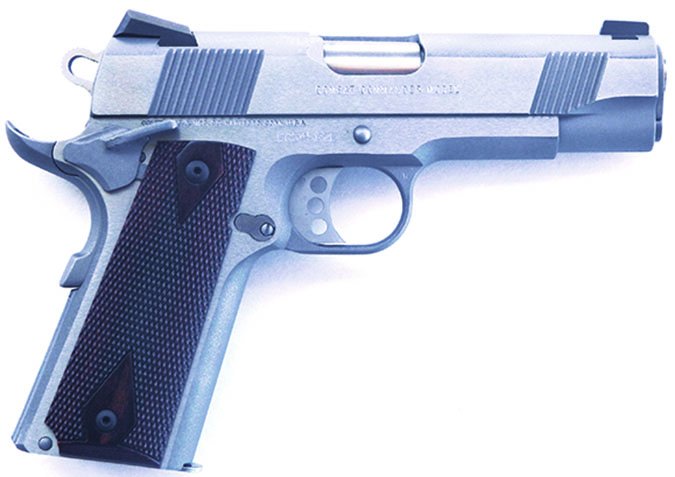
The Colt was consistently an accurate handgun with every load. Plus, the ambidextrous safety, forward cocking serrations, and frame cut gave the Colt a good feel and superior handling.
| STATS | |
|---|---|
| ACTION | Locked Breech Single-Action Semi-Auto, Series 80 |
| OVERALL LENGTH | 7.75 inches |
| OVERALL HEIGHT | 5.4 inches |
| MAXIMUM WIDTH | 1.5 inches |
| WEIGHT UNLOADED | 36 ounces |
| WEIGHT LOADED | 40.5 ounces |
| BARREL LENGTH | 4.25 inches |
| BARREL | Steel, 1:16 Twist |
| CAPACITY | 8+1 |
| SLIDE | Brushed Stainless Steel |
| FRAME | Brushed Stainless Steel |
| FRAME FRONT STRAP HEIGHT | 2.6 inches |
| FRAME BACK STRAP HEIGHT | 3.2 inches |
| GRIPS | Double Diamond Checkered Rosewood |
| GRIP THICKNESS | 1.3 inches |
| GRIP CIRCUMFERENCE | 5.4 inches |
| REAR SIGHT | Steel, Two White Dot, Novak Carry |
| FRONT SIGHT | Steel, One White Dot, Novak Carry |
| TRIGGER PULL WEIGHT SINGLE ACTION | 6 lbs. |
| TRIGGER SPAN SINGLE ACTION | 2.5 lbs. |
| SAFETIES | Ambi Slide Lock; Upswept Beavertail Grip |
| WARRANTY | Limited Lifetime |
| WEBSITE | Colt.com |
| MADE BY/IN | Colt’s Manufacturing/USA |
While the debate continues on about which firearm is the best combat handgun, the 1911 remains in the running, and, according to some, it stays at the top of the heap. The 1911 has many applications including target practice, competition, and self defense, of course.
Simple pride of ownership is never a bad reason to own a handgun, but personal defense remains the defining characteristic of the 1911 handgun. For many, the 1911 represents the best choice for repelling boarders or facing members of the criminal class.
For this task, the pistol has good features, including speed to an accurate first shot that is virtually unequaled, reliability, and accuracy. Also, the 1911 is thin enough for concealed carry. The problem is a full-size gun’s profile and weight. The 1911 can be concealed effectively with proper holster selection, that isn’t the question. The question is the comfort level the individual is willing to accept. For many of us, the steel-frame Commander with its -inch-shorter slide and barrel solves the problem. The Commander pistol is less likely to pinch the bottom when seated, and it is faster from the draw as well.
Reader Steven Mace of Arizona wrote us in April 2014 asking if we would consider testing a list of 1911A1 Commander-style pistols. He wrote, “If you or your staff has any experience with any of these pistols, I would appreciate any information that could be shared. Or, are there any plans to evaluate any of these pistols in the near future? My intent is to find and buy a 1911A1 for concealed carry for a person who is left-handed.” His list of desired handguns included the Colt XSE O4012XSE.
The Colt Commander XSE is Colt’s top-end Commander. For a few hundred more dollars above the Remington R1 you get a full-length guide rod, Novak sights, forward cocking serrations, and nicely checkered custom-grade rosewood grips. The hammer was a lightweight skeletonized version which we often find on higher-end guns.
Though it may not seem like it, it’s easy for a pistol to make a good first impression on us, and the Colt did just that. When checking sight regulation at the start of our firing phase, we shot the Colt Commander pistol off a bench rest at 15 yards. The rater fired three rounds to test the relationship between the sight picture and point of impact, then he walked to the target. Result: Two rounds in the same hole and the other very close and directly on point of aim. That’s a good start.
The Colt Commander’s ambidextrous safety can be used by both righties and lefties, or as an either/or tactical choice for users who might be injured and have to switch to opposite-handed firing. Trigger compression was clean with no creep or backlash at 6.0 pounds, one pound more than the Remington.
During disassembly, we noted the barrel bushing fit was tight, and the barrel locking lugs were well fitted. We saw little lateral play in-the-slide-to-frame fit. The slide-lock safety and the grip safety each exhibited positive function.
The Colt featured a cut out just under the trigger guard that slightly lowers the bore axis, resulting in a better fit for some shooters.
Our Team Said: This was among the most accurate Commander pistols we have tested. After firing 250 rounds without a malfunction, we deem the Colt Commander XSE to be an excellent choice for personal defense. The goal of many shooters is to be able to defend themselves and their loved ones, and some training should follow this decision. But training is easier, more effective, and more fun with a tool like the Colt XSE.
Ruger 22/45 Lite 3908 22 LR, MSRP $515
Gun Tests grade: A
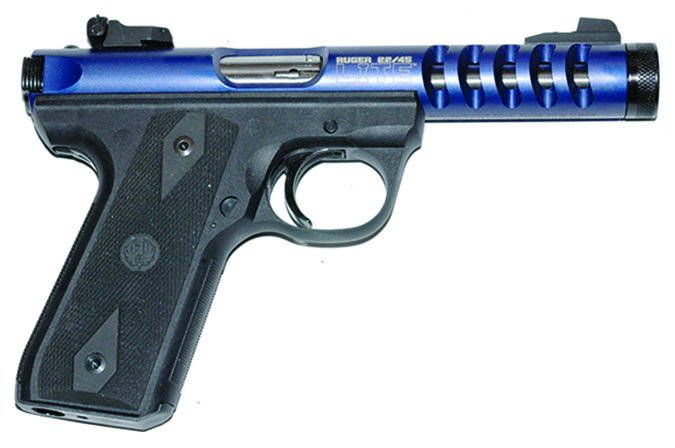
With its 1911-like grip that is essentially the same size as the big 45s, the new blue Ruger fit our 45 holsters. All the controls are in the same places as found on the 1911 45s.
| STATS | |
|---|---|
| OVERALL LENGTH | 8.4 inches |
| OVERALL HEIGHT | 5.5 inches |
| MAXIMUM WIDTH | 1.1 inches |
| WEIGHT UNLOADED | 22.8 ounces |
| WEIGHT LOADED | 24 ounces |
| BARREL LENGTH | 4.4 inches |
| BARREL | Stainless Inside Aluminum |
| CAPACITY | 10+1 |
| SLIDE | |
| FRAME | Black Polymer |
| FRONT STRAP HEIGHT | 2.7 inches |
| BACK STRAP HEIGHT | 3.5 inches |
| GRIP | Black Polymer |
| GRIP THICKNESS | 1.1 inches |
| GRIP CIRCUMFERENCE | 5.2 inches |
| SIGHT RADIUS | 6.5 inches |
| TRIGGER PULL WEIGHT | 4.6 inches |
| TRIGGER SPAN SINGLE ACTION | 3.2 inches |
| WARRANTY | None |
| WEBSITE | Ruger.com |
| MADE BY/IN | Sturm, Ruger/USA |
The avid woodsman or outdoorsman, be he/she hunter, hiker, camper, or what have you, has certain necessary items that must always be packed along on the trail. Many of us also want a pistol, such as Ruger’s new 22/45 Lite in 22 LR. The new blue Ruger looks like a Buck Rogers pistol with its cutaway barrel and Picatinny-like top rail. The gun is also available with a Cobalt, or gray, finish with holes drilled in the barrel shroud instead of the deep cuts of our test sample, but the Cobalt one does not come with a sight rail. We see the blue Ruger as a light, efficient, outdoorsman’s pistol, so the idea of sticking a scope on it was not for us. Yet we recognize that many shooters need that option. For fun and because we could, we tried the rail with a 30X Weaver target scope on it, but for the bulk our testing, we took off the scope and the top rail, which was attached with three short screws. We appreciate that Ruger makes it easy to mount a scope on the blue pistol, but with the rail, the gun would not fit into a Bachman Slide holster. With the rail off, the gun fit nicely.
The pistol came with a soft zippered case and two magazines, plus an Allen wrench to remove or tighten the top rail. We noted the gun will not fire with the magazine removed. It is also possible to work the bolt with the safety in the On position, so one can load and unload the chamber with an added degree of security. There was a key for the integral action lock. The 22/45 Lite was made exceptionally well, and it always worked properly.
As most readers know, the grip angle of the Ruger 22/45 is essentially identical to the Colt 1911 pattern. The controls to release the magazine and operate the safety are in the same places as on the big 45s. The Ruger’s frame is Zytel polymer. The front grip strap is horizontally serrated and the rear strap is checkered. The side panels are rubber. Grips from the Ruger Commander reviewed previously looked like they might fit, but they didn’t.
We shot the Ruger using its excellent adjustable sights — they gave a perfect sight picture for our eyes — using Federal Gold Medal Premium Match, Eley Tenex Ultimate EPS match, Blazer, and CCI MiniMags. We had trouble with the Eley match ammo, which did not want to feed reliably in this brand-new pistol. We’ll try it again after more rounds have gone through the Ruger, but we can’t dun the new pistol for that. The Eley ammo’s recoil is exceptionally light, which seemed to have been the problem. The Tenex bullets came out at about 900 fps, and all the other ammo including the Federal Match was significantly faster.
At 50 feet with the iron sights, we shot our very best group with Blazer rimfire rounds, 0.6 inch. That ammo averaged under an inch, the best of this test, followed by the Federal Gold Medal and Tenex average groups, 1.4 inches, and the MiniMags at 1.2 inches. A long-eye-relief, low-power scope or any of the floating-dot sights would be ideal for those whose eyesight requires help.
Other than the too-light ammo in a crisp new gun, we had no trouble at all with the Ruger. Its trigger pull was excellent, crisp and clean. It broke at 4.6 pounds. We noted how easy it was to get pinched by the closing bolt, so rather than ease it forward with our fingers, we simply took to letting its own spring slam it closed.
Our Team Said: We would buy the Ruger 22/45 Lite for most of our smallbore needs.
Beretta A400 Xplore Action J40AA88
28 Gauge, $1550
Gun Tests grade: A

Very responsive with rapid cycling, this handsome shotgun was a pleasure to shoot. Dense patterns indicated greater long-range capability than one might expect.
| STATS | |
|---|---|
| ACTION TYPE | Gas-Operated, Semi-Automatic |
| CHAMBER SIZE | 2.75 inches |
| OVERAL LENGTH | 48.5 inches |
| CAPACITY | 2+1 |
| WEIGHT UNLOADED | 5.4 lbs. |
| BARREL LENGTH | 28 inches |
| BARREL | Blue |
| RECEIVER | Bronze Anodized Alloy |
| CHOKE TUBES | Full, Modified, Cylinder Bore |
| STOCK | Walnut Checkered |
| BUTTSTOCK LENGTH OF PULL | 14.5 inches |
| BUTTSTOCK DROP AT COMB | 1.35 inches |
| BUTTSTOCK DROP AT HEEL | 1.9 inches |
| FOREARM | Walnut Checkered |
| FRONT BEAD | Fiber-Optic |
| REAR BEAD | N/A |
| RIB WIDTH | .20 inches |
| TRIGGER | 5.5 lbs. |
| WARRANTY | 3 Years with Registration |
| WEBSITE | BerettaUSA.com |
| MADE IN | Italy |
A sub-gauge semi-auto shotgun we liked this year was the Beretta A400 Excel Action, which we acquired from the Pro Shop at American Shooting Centers in Houston (AMShootCenters.com). The Beretta shotgun arrived in a lockable takedown hard case that was well made but was probably not substantial enough for air travel. If there was any doubt why this shotgun cost so much, this notion was erased on first sight. The wood stocks showed a burl-like pattern of dark and light with a mild grainy texture. That the grain pattern was not all of one color and glossed meant the buttstock and forearm had to be fashioned from the same section of wood for it to match. The pistol grip was checkered in three contours on each side. The forearm was wrapped with checkering, and the underside featured the Beretta emblem of three arrows inside an oval.
Additional contours to the stock included a relief leading from the lower edge of the buttstock, a significant narrowing before the pistol grip, and a shallow relief forming a grip along both sides of the forearm. The buttstock offered a solidly mounted swivel stud. Forward connection for the sling swivel was at the top of the magazine cap. A set of detachable sling loops was supplied. The A400 Xplore Action shotguns typically feature a compressible recoil-reduction system installed within the buttstock. But when chambered for the milder 28-gauge ammunition, recoil is handled only by a buttpad composed of open-cell polymer foam. One option that was available was a shorter 26-inch barrel, which would make it even lighter and more compact for an easy day in the field.
The supplied choke tubes were Beretta’s Optimachoke configuration. The receiver was a bronze color, and its topside was machined with four mounting points, specifically for Beretta’s proprietary scope rings. Seated flush on the left side of the receiver was the magazine cutoff switch. Pushing one side inward, this enabled the shooter to pull back the bolt and eject a live round without drawing a fresh round from the magazine. It also allowed the elevator to be pushed upward so that the magazine can be unloaded manually. For where it is required by law, a stainless-steel magazine plug that turned the Beretta into a single shot was supplied. Cycling was achieved by gas vented from a small cylinder driving a short-stroke piston with enough pressure to drive the rotating bolt. This system was also designed to drive out debris, keeping the cylinder clean.
The Beretta trigger had virtually no creep and little if any discernible take-up. We would compare it to the type of trigger that might be found on a match rifle, but our scales told us that the pull weight registered a full 5.5 pounds. Measured repeatedly, trigger-pull weight did not vary.
The Beretta was shipped with two plastic shims and a steel connector plate that can be applied so that the stock is cast for right- or left-handed shooters as well as for a range of drop angles. The pistol grip was neutral in terms of palm swell or other contour, and the gun arrived cast for a right-hand shooter. At the pattern board we learned that the shot was very close to 50/50. This means that about half the pellets hit the target above our point of aim. The Estate 2.75-inch 7 shot Super Sport Competition Target load showed a tight pattern, with many hits overlapping. Certainly, we could have changed to a lighter constriction for the Skeet field.
After several rounds of skeet, our shooters agreed that the Winchester ammunition was the best choice. Looking back at our HunterJohn pattern targets, we found that preference for the Winchester rounds could have been predicted by the results. While all three test rounds produced solid patterns, the Winchester target showed its primary density described nearly a perfect circle, even as the shot pattern thinned toward the edges.
The 28-gauge Xplore Action weighed in at only 5.4 pounds, and with the 28-inch-long barrel, we expected the gun to be whippy. But the Beretta felt rigid once shouldered, more like a rifle than a lightweight shotgun. Yet not one shooter on our staff or any of our guest shooters complained about discomfort from recoil. Our most experienced skeet shooter noted that with the smaller pattern of the lesser gauge, you really had to be right on.
Our Team Said: The 28-gauge Beretta Xplore Action shotgun sets a high standard. Not only is it a very handsome shotgun, but its cycling impulse was much less apparent than other self-loading shotguns we’ve tried.
Springfield Armory Loaded Target PI9134LP 9mm Luger, $873
Gun Tests grade: A
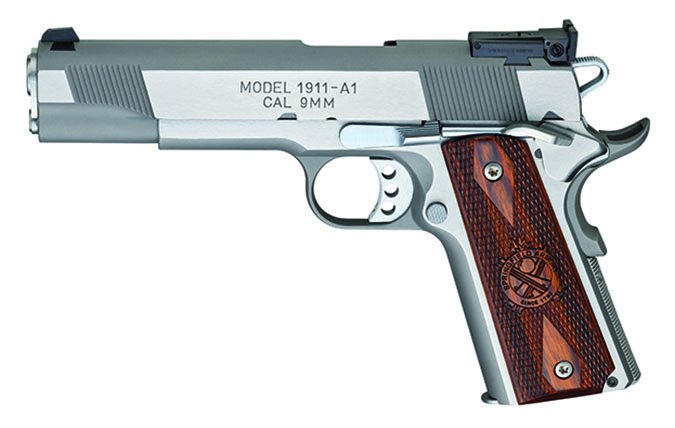
Function of the Loaded Model was flawless. The pistol features stainless construction, always a plus in a tactical handgun. The forward cocking serrations and ambidextrous safety are helpful for tactical shooting. The Loaded pistol’s nice trigger made the deal for us.
| STATS | |
|---|---|
| ACTION | Locked Breech, Single-Action Semi-Auto |
| OVERALL LENGTH | 8.5 inches |
| OVERALL HEIGHT | 5.3 inches |
| MAXIMUM WIDTH | 1.5 inches |
| WEIGHT UNLOADED | 40 ounces |
| WEIGHT LOADED | 44 ounces |
| BARREL | 5 inches Long, 1:16 Twist; Matched Grade Stainless Steel; Supported Ramp |
| RECOIL SYSTEM | 2-Piece National Match, Full-Length Guide Rod |
| MAGAZINES | (2) 9-Round Stainless Steel |
| SLIDE | Forged Stainless Steel; with Matte Rounds; Polished Flats; Front & Rear Serrations |
| FRAME | Forged Stainless Steel; with Matte Rounds; Polished Flats |
| FRAME FRONT STRAP HEIGHT | 2.6 inches |
| FRAME BACK STRAP HEIGHT | 3.2 inches |
| GRIPS | Cross Cannon Double Diamond Checkered Rosewood |
| GRIP THICKNESS | 1.5 inches |
| GRIP CIRCUMFERENCE | 5.5 inches |
| REAR SIGHT | Elevation & Windage Adjustable |
| FRONT SIGHT | Post, Dovetailed |
| TRIGGER PULL WEIGHT SINGLE ACTION | 5 lbs. |
| TRIGGER SPAN SINGLE ACTION | 2.4 inches |
| SAFETY | Slide Lock, Grip |
| WARRANTY | Lifetime |
| WEBSITE | SpringfieldArmory.com |
| MADE BY/IN | Illinois/Springfield Armory |
The Springfield Loaded Model Target is a logical extension of the successful Loaded Model line. The pistol was well fitted, well finished, and overall was an attractive handgun. For an additional $169 dollars in the Loaded Model, you get forward cocking serrations, a full-length guide rod, stainless-steel construction, and an ambidextrous safety. The right-hand slide-lock lever (for left-handed shooters) of the Loaded Model safety was well designed and supported by the stocks, we saw.
The Loaded 9mm Stainless Steel has a polished finish on the flat surfaces and bead-blasted matte finish on the rounded areas. The 5-inch barrel is a match-grade stainless steel unit. The slide features slanted serrations on the front and rear. The mainspring housing is flat and includes the company’s integral locking system, or I.L.S., which replaces the mainspring housing of the handgun. When engaged, the I.L.S. prevents the hammer from moving by locking the mainspring cap, making the gun inoperable. Elsewhere, the pistol has a lightweight Delta hammer and a beavertail grip safety with raised memory pad for positive engagement. The extended thumb safety is ambidextrous, and it has a long aluminum match-grade trigger. The pistol is fitted with a two-piece full-length guide rod. The grips are held in place with Torx grip screws.
To our eyes, the biggest advantage of the Loaded Target was its stainless-steel construction, an obvious plus for a hard-use pistol to be worn in all types of weather. The full-length guide rod (FLGR) is sometimes criticized as adding to the complexity of field stripping. However, the FLGR also prevents the pistol from going out of battery when jammed against the barricade and may be an aid when firing heavy loads.
When the sum of the advantages of the Loaded Model are added up, it seemed to us that it was a pistol better suited for tactical use. The forward cocking serrations, full-length guide rod, and stainless-steel construction are good to have. The ambidextrous safety is a help to allow use of the handgun by either hand. A left-handed shooter would prefer the set up even more.
With a mix of 40 Fiocchi 115-grain Extrema rounds, 35 HPR 124-grain XTPs, 25 Fiocchi 124-grain JHPs, and 40 Winchester 115-grain USA cartridges, there were no failures to feed, chamber, fire, or eject. During testing of sight regulation and the ability of the sights to be zeroed, we also used the Fiocchi 92-grain hollowpoint. All proved reliable, as did the Fiocchi 147-grain XTP. These sights are fully the equal of any we have tested from any maker, including the Bo-mar sight.
The lighter trigger compression of the Loaded Model was deemed an advantage. The most accurate loading in the Loaded was the Hornady 147-grain XTP, with the best effort being a 1.6-inch group.
Our Team Said: For the tactical shooter, the practical advantages of the stainless Loaded Target make it a great buy.
Kimber Micro Carry Advocate 380 ACP $796
Gun Tests grade: A-
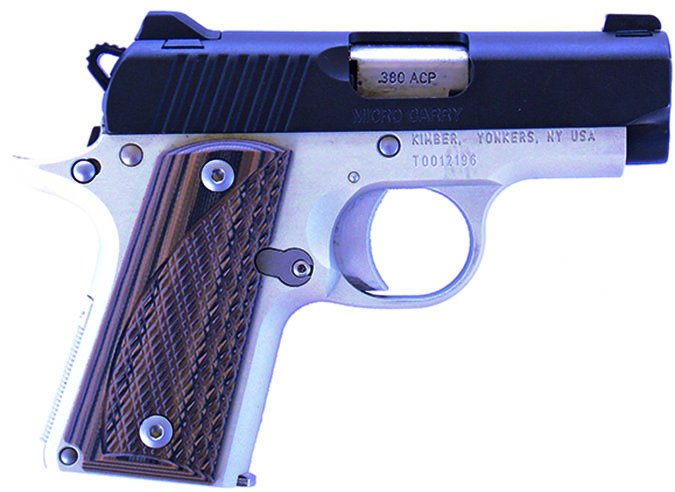
The Kimber was well finished and demonstrated excellent reliability and accuracy. It also fit in a pocket.
| STATS | |
|---|---|
| ACTION | Locked Breech Single Action Semi-Auto |
| OVERALL LENGTH | 5.6 inches |
| OVERALL HEIGHT | 4 inches |
| MAXIMUM WIDTH | 1.1 inches |
| WEIGHT UNLOADED | 13.8 ounces |
| WEIGHT LOADED | 16 ounces |
| BARREL | 2.75 inches; Stainless Steel 1:16 LH Twist; Ramped |
| SLIDE | Steel |
| MAGAZINE | 6 Round Detachable Box |
| FRAME | Aluminum |
| FRAME FRONT STRAP HEIGHT | 1.6 inches |
| FRAME BACK STRAP HEIGHT | 2.25 inches |
| GRIPS | G10, Brown |
| GRIP THICKNESS | 1 inch |
| GRIP CIRCUMFERENCE | 4.62 inches |
| SIGHTS | 3-Dot Tritium |
| SIGHT RADIUS | 3.9 inches |
| TRIGGER PULL WEIGHT | 8.75 lbs., Solid Aluminum |
| TRIGGER SPAN SINGLE ACTION | 2.1 inches |
| SAFETY | Frame-Mounted Lever |
| WARRANTY | 1 Year |
| WEBSITE | KimberAmerica.com |
| MADE BY/IN | Kimber USA/New York |
The Kimber Micro Carry Advocate Brown 380 ACP, $700, isn’t as close to the 1911 template as some others. Close enough for intuitive handling if you are familiar with the 1911, but the details differ greatly. These differences may be a deal breaker in either direction. If you do not like the 1911 grip safety, the Kimber is your choice.
Elsewhere, the Kimber we tested was well made and finished, with a blue-steel slide and anodized-aluminum frame. The checkered wooden grips were very attractive. The Kimber was supplied in a padded case with a spare 7-round magazine with finger extension, but the magazine we used for our measurements was a 6-round design.
The sights were good combat sights, three-dot sights with tritium inserts, a big advantage on a personal defense pistol. The Kimber uses the internal extractor common to other 1911 handguns. However, the Kimber does not use a grip safety. With a pistol bordering on tiny, a grip safety would have been difficult to incorporate into the design.
The frame of the Kimber extended in a generous beavertail tang that aided in comfortable firing. The hammer of the Kimber rides deeply in the slide, which will be a good thing if shooters opt to carry the pistol with the hammer down while in the pocket. The pistol disassembled much the same as any other 1911, except that the pistol featured a metal one-piece guide rod and wound recoil spring. The Kimber also uses the angled camming surfaces of the Browning type instead of the 1911 swinging link. When the pistol is disassembled, there is a loaded spring under the slide stop to maintain pressure on the stop. Reassembly isn’t hard, but the small wire ejector must be depressed.
There was no magazine safety. Few American-designed pistols use the magazine safety, and no service pistol that we are aware of in use in this country still uses a magazine safety. The Kimber featured a positive firing pin block. The slide-lock safety, well, isn’t a slide-lock safety. The thumb safety does not lock the slide. This allows loading the pistol with the safety on. On this subject, we found the safety to be a positive. While carrying the pistol cocked and locked in the pocket, the safety never rode off its indent. Just the same, the raters reached a consensus that each would probably carry the pistol in the pocket hammer down. In a proper, well-made pocket holster, cocked and locked is viable, and every pocket pistol should be carried in a holster. The safety may be applied with the hammer down, which doesn’t have much value. Do not move the safely to the on position with the slide off the frame, or the safety may fall out of the frame.
A feature of the Kimber we did not like was the heavy trigger. The trigger operated with minimal take-up followed by firm consistent pressure, but it broke at 8.75 pounds when the company claims it should be set to 7.0 pounds. Just the same, we did great shooting with the pistol.
To get started, we lubricated the Kimber and then loaded both magazines with Black Hills Ammunition 100-grain ball ammo. We concentrated on the magazine without the finger rest during control testing, as this is the magazine we think most shooters will be carrying in the pistol. The advantage in control, if any, was slight with the larger magazine. By the same token, the extra height did not seem to adversely affect concealed carry. The Kimber proved tractable and gave good results in short-range drills. When firing off the bench for best accuracy, the heavy trigger was more of a challenge than in combat shooting. All raters commented that the pistol was easy to fire quickly and to keep on target, probably because of the light recoil of the 380 ACP cartridge. When firing the first few groups, we registered a number of 4- and 5-inch groups at 15 yards, definitely in the pocket-pistol class of not-so-hot accuracy. Finally, after some effort, we were able to print a number of groups in the 3-inch class. The best group came with the Hornady 90-grain FTX, which shot a 2.5-inch cluster at 15 yards.
Our Team Said: The Kimber costs somewhere around $800, depending on where you shop. Part of the cost is seen in the Advocate’s superior fit and finish, tritium sights, and a spare magazine. It would have earned a straight A grade except for its too-heavy trigger.
LWRCI M6A2 Gas Piston Carbine M6A2R6B16
6.8 SPC, $2250
Gun Tests grade: A

This is a well-put-together gun with heavy-duty components.
| STATS | |
|---|---|
| ACTION TYPE | Semi-Automatic Short-Stroke Gas Piston; LWRCI Nickel Coating |
| OVERALL LENGTH | 33.5-36.5 inches |
| OVERALL HEIGHT | 10.25 inches |
| WEIGHT UNLOADED | 8.2 lbs. |
| WEIGHT LOADED | 9.5 lbs. |
| UPPER RECEIVER | Midlength Free-Float Rail; Low-Profile Gas Block |
| LOWER RECEIVER | Black Aluminum Alloy, Magpul MIAD Grip |
| BARREL | 41V45 Steel Alloy; Match Grade. 16.1 inches, 1:10 RH Twist, Target Crown |
| MUZZLE DEVICE | A2 Birdcage 5/8×24 TPI |
| BUTTSTOCK | Black VLTOR EMod, Adjustable 4-Pos. |
| LENGTH OF PULL | 11.4-14.5 inches |
| HANDGUARD | Quadrail with 3 Polymer Covers |
| MAGAZINE | (3) Barrett 30 Round |
| REAR SIGHT | LWRCI Folding BUIS |
| FRONT SIGHT | LWRCI Folding BUIS |
| SIGHT RADIUS | Up to 14.25 inches |
| TRIGGER | 7.5 lbs., Mil-Spec Single Stage |
| SAFETY | Left Side 2-Pos. Lever |
| CARTRIDGE CASE DEFLECTOR | Yes |
| DUST COVER | Yes |
| WARRANTY | Limited Lifetime |
| WEBSITE | LWRCI.com |
| MADE BY/IN | LWRCI/Maryland |
| NOT AVAILABLE IN | CA, CT, DC, HI, MD, MA, NJ, NY |
The 6.8 SPC round, topped with appropriate hunting bullets, is currently being used in the field to harvest deer, hogs, and other large game. Thus, our interest in testing the LWRCI M6A2. The 6.8 SPC is a cartridge that pushes the performance envelope for the AR-15 platform. Over time, there have been several specifications published for the chamber, with a great deal of discussion regarding the compatibility between the different specifications. However, the available data shows the differences between chamber specs are minimal, so compatibility should not be a problem in most cases.
The LWRC International M6 series rifles are rotary-bolt, magazine-fed, air-cooled, self-loading designs chambered in 5.56x45mm NATO and 6.8x43mm SPC. Our test unit was the M6A2 version, which has a low-profile gas block with a mid-length quad rail and heavy-duty polymer rail covers. The M6A2 retains about an 80% parts commonality with the direct-impingement carbine.
The LWRC International M6A2U6B16 ships standard with a box and one 30-round magazine. Our private-sale gun, $1499, came with three mags, however.
LWRCI says its patented self-regulating short-stroke gas-piston system eliminates the venting of hot, carbon-laden gases into the receiver and bolt carrier group, thus eliminating the intensive cleaning regime of the “legacy” rifle. We found the LWRCI M6 easily field stripped and cleaned like any other piston AR. As is common with piston-driven rifles, the bolt showed little carbon fouling. A normal amount of carbon and copper fouling was in the bore.
Another supposed benefit of the company’s short-stroke gas-piston system is improved handling characteristics, lighter recoil, and reduced muzzle rise. On our first testing day, our team started shooting the SSA 115 OTM with no failures, and our team commented on the rifle’s even pulse and mild recoil. It was slightly more than a 5.56 round, we thought. We had no failures with the SSA 85-grain frangible and noted the same even pulse and mild recoil, which we thought was no more than a 5.56 round. The Hornady 110-grain V-Max likewise had no failures and felt the same as the SSA 115s. The brass fell in a 6-foot circle behind and to the right of the shooter.
What we found with the M6A2 was a well equipped unit with an extensive rail system, rail covers, back up iron sights (BUIS) and a heavy-duty collapsible stock. Despite the weight, the rifle was well balanced and shot well from a variety of field positions. The rifle gave off a general sense of quality. The fit was tight and the finish showed consistent coloration. The controls were smooth and positive. The rifle was provided with three magazines manufactured by Barrett, which were clearly marked on the outside with the caliber. They locked and ejected easily. The bolt and bolt carrier were particularly nice, with a The LWRCI showed a preference for the Silver State Armory ammunition, shooting the 85-grain frangible lead-free bullets into 1.4-inch average groups and the 115-grain OMT into 1.6-inch average groups. The Hornady ammo lagged at 2.0 inches. The rifle proved completely reliable with boxed ammunition.
The Magpul MIAD grip was comfortable, and its adjustable backstraps made individual fitting possible. Up top, any Mil Std 1913 accessory can be mounted to the rail, and because the rail is monolithic, the shooter can bridge devices from the receiver to the rail.
Our Team Said: This is a well-built, reasonably accurate 6.8 SPC-chambered rifle suitable for hunting.
Mako Group FAB Defense Survival Buttstock GL-MAG, $122; and Monopod Buttstock
Add-On MBA, $97
Gun Tests grade: A
BEST IN CLASS ACCESSORY
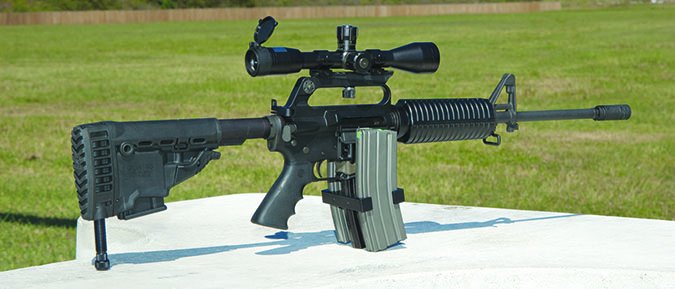
The Survival Buttstock was very comfortable against the shoulder and cheek. The addition of the flat surface supplied by the magazine basepad located at the rear of the buttstock helped when shooting prone or from a bench. Also stored one standard AR-15 magazine. The Add-On is a separate buttpad with a two-stage adjustable-height monopod. The Monopod Buttstock Add-on adds about 1.2 inches in stock length and is an easy slip-on install. The monopod is adjustable, with two stages of extension.


























